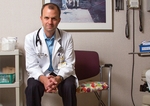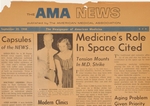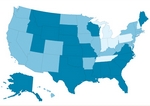Health
Stepping up to the plate: Hospitals move toward healthy eating
■ It's becoming increasingly easy to find healthy food at hospital cafeterias, and often, physicians are leading the way.
By Susan J. Landers — Posted Jan. 2, 2006
- WITH THIS STORY:
- » Healthy hospital food gets a boost
- » External links
- » Related content
A quick lunch at the hospital cafeteria doesn't have to be a burger and fries. In fact, finding a fast-food restaurant on the premises might not be as easy as it used to be. Hospitals are trying to provide healthier food for staff as well as patients. And the reason why is clear: Physicians and nurses have not escaped the nation's collective weight gain.
For them, losing those extra pounds picked up during this season of heavy eating might not mean brown-bagging it to work. Healthy choices are often available just an elevator ride away.
For example, some selections at several Washington, D.C., hospitals can be decidedly good for you. On a recent lunchtime tour, George Washington University Hospital's cafeteria was serving lemon pepper fish (1 gram of fat and 150 calories) while a few miles away, Sibley Memorial Hospital featured beef burgundy over noodles (11 grams of fat and 410 calories).
Heart symbols at Washington Hospital Center's cafeteria mark selections approved by the American Heart Assn. And staffers at Children's National Medical Center were spotted late one Sunday morning diving into a plate of bright green broccoli and a bag of soy nuts.
Some hospital cafeterias have even succeeded in attracting people who don't have to be in or near the hospital. Such is the case with the Cleveland Clinic's Naples, Fla., campus. "When the Naples season is in full swing, it's not unusual to find folks who don't have medical appointments stopping in the hospital cafeteria to have lunch," said Victoria Agnew, the clinic's director of media relations.
D. Scott Madwar, MD, clinic chief of staff, believes in providing an environment of healthy eating and healthy living. "The food choices offered in the cafeteria are low-fat items, and that's on purpose," he said. "The best way to get our patients to engage in healthy behaviors is by role-modeling. So the majority of physicians and nurses on our staff are aware of these things and motivated toward taking care of themselves."
Back in Cleveland, Delos M. "Toby" Cosgrove, MD, chief operating officer at the main campus of the Cleveland Clinic and a heart surgeon, is also stepping up to the plate, so to speak. He wanted all fast-food restaurants removed from the premises when he took the reins at the hospital in 2004, said Eileen Sheil, spokeswoman for the hospital. Pizza Hut is gone, and negotiations with McDonald's, which has nine years left on its 20-year lease, have resulted in some healthier menu options.
"He wanted to walk the talk of health and health promotion," Sheil said. "He's in surgery every day and sees what obesity does to people."
Still, though you can lead people to healthy food, you can't make them eat it, Dr. Madwar noted. For that to happen, education is the key.
Others agree. "I think if you wanted to eat healthy, you could certainly find choices," said Laura F. Wilwerding, MD, referring to the University of Nebraska College of Medicine's cafeteria. Dr. Wilwerding is a clinical associate professor of pediatrics at the college.
There's a well-stocked salad bar, a deli with freshly made sandwiches, a pasta bar and a specialty grill that recently featured ginger chicken stir-fry. "I think for a hospital, they don't do too badly," she said. "The problem is that people don't usually make the healthiest choices for themselves. The line for french fries, onion rings and other fried treats is always long."
Hospitals should post nutrition facts and healthy eating tips directed toward decreasing calorie consumption, she said. "Many times, if people were aware of how bad the foods they eat are, they would make a better choice."
Healthy vending choices
It was precisely this reasoning that led Arthur "Tim" Garson Jr., MD, MPH, dean of the University of Virginia School of Medicine in Charlottesville, to wage a campaign against unhealthy snacking from the medical school vending machines.
"It came from looking at whether we should not have an overall tax on fatty food, just like a tax on cigarettes and alcohol, given the prevalence of obesity and the fact that obesity is going to rank up there with smoking as one of the increased causes of death," he said.
So the medical school created its own vending machine "sin tax." But it was only a nickel, and it probably didn't turn many staff members away from the M&Ms and Coke. What well may have worked was the color-coding system keyed to educational information that went along with it.
Borrowing from traffic signals, Dr. Garson and colleagues placed red stickers on options containing more than 40% fat and 200 calories. Items that were 35% to 40% fat and 140 to 200 calories had yellow stickers, and those with less than 5% fat and fewer than 140 calories were coded green. The red tagged items carried the five-cent surcharge.
The result was a win-win situation for all, Dr. Garson said. In the first year of the experiment, from May 2004 until April 2005, sales of red items went down 5%, yellow items were up by 30% and green increased 15%. And the school sent more than $7,000 worth of nickels to a center that helps overweight children to reduce.
The vendors also won. Overall sales of snacks in the machines increased 11%.
"The trend to low-fat and low-calorie snacks confirms what we know instinctively," Dr. Garson said. "People want to get healthier and will make better choices with just a little education."
The education consisted of large informational signs on the machines explaining the project. "We need to let people know there are serious consequences associated with poor eating habits and tell them about the healthier alternatives," he said. The program has attracted the attention of a state government building in Richmond, Va., as well as other medical schools in the United States and Europe.
But there is still a way to go before healthy hospital food is a broad reality. The Physicians Committee for Responsible Medicine, a Washington-based, nonprofit group that advocates preventive medicine, recently conducted a nationwide survey and found some good news and some bad.
The survey of 25 hospitals or hospital systems from 17 states revealed that the majority of hospitals are trying to offer some health-promoting food choices, but many entrees described as healthy by hospitals are actually very high in fat.
And the popular foods were also not the healthiest. Fried chicken was the top-selling entrée in 24% of the hospital cafeterias surveyed, and hamburgers were the No. 1 selling entrée in 12%. Other top sellers included pizza, enchiladas, meatloaf, catfish, sandwiches and various food stations such as Mexican, Asian, Italian, salad bars or baked-potato bars.
Meanwhile, the AMA has also gotten involved. Its policy-setting body passed a resolution at last June's Annual Meeting promoting the availability of healthy food options in hospital cafeterias. The driving force behind this resolution was Jeffrey Krebs, MD, an internist with Kaiser Permanente in San Diego.
The idea for a resolution began to take shape three years ago when he walked into the Children's Hospital and Medical Center in San Diego with his 7-year-old nephew, who quickly spotted the Golden Arches and requested a Happy Meal.
"It was then that I realized there was a full-service McDonald's restaurant in the hospital, and I was appalled. ... I have nothing against McDonald's or any other fast-food restaurant, because people have a choice whether they want to eat that food or not," Dr. Krebs said. "But I do have an issue with having unhealthy foods served in hospitals, because it is a tacit endorsement, in my opinion, of that type of food."
Other options
Although physicians and nurses also might eat at McDonald's, there is another option, said Tom Hanscomb, spokesman for Children's Hospital. There is a cafeteria on the premises. "We have an extremely strict nonsmoking policy, but how far do you take the argument on choice of food?"
Dr. Krebs would like it to take the McDonald's out of the hospital or, at least, result in improvements to the menu. "There are doctors and nurses at the hospital who eat there every day. It is easily accessible, and [the food is] tasty because there's a lot of fat and salt in it."
But he does detect some signs of change. There are now substitutions allowed in Happy Meals. For example, alternatives to french fries are offered, and instead of soda, kids can get milk or juice, he said. McDonald's "is finally trying to do a few healthier things." McDonald's did not return phone calls for this article.
Meanwhile, Dr. Krebs brings his own lunch to work. "I really try hard to practice what I preach and control the fat and sodium in my diet. It would be hypocritical of me not to follow my own advice if I'm telling patients every day to exercise, lose weight and eat healthy."
His resolution sailed through the California Medical Assn.'s house of delegate's annual session last year and was taken to the national level. "I understand it passed without any changes there as well," he said.
Positioned to make an even greater impact on hospital food are Aramark Corp. and SodexhoUSA, the two large corporations contracted to manage thousands of hospital cafeterias. Both have developed healthy eating programs and have tested recipes that meet specific guidelines.
Sodexho's has about 8,000 recipes in "Wellness and You," its program for healthy eating.
Jeremy Hough, general manager and director of food and nutrition at GWU Hospital, uses that giant recipe book daily.
But the recipes still might need to be tailored to the clientele, he said.
Regional tastes and food expectations for employees born and raised in the Washington, D.C., area create a demand for grits, sausage, bacon and biscuits -- not the healthiest items.
"We need to please our customers and give them what they want, but we also need to give them the option of living a healthier lifestyle through the food we offer," he said.
The key seems to be to persuade everyone that the healthier choices should always rule.












